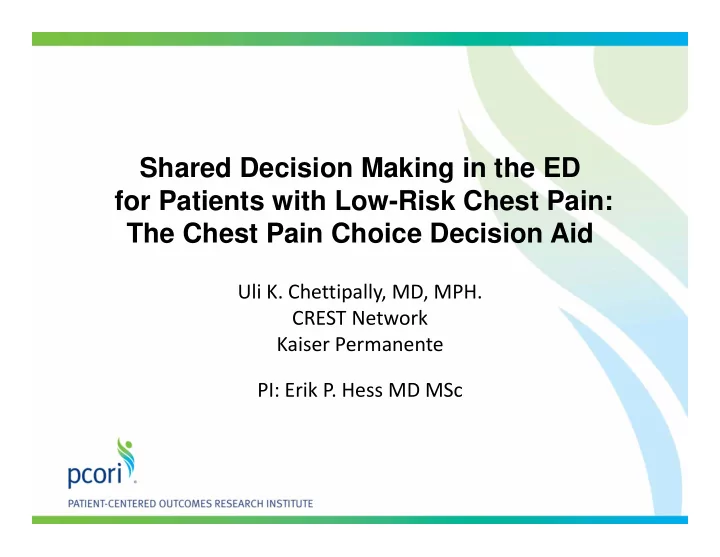

Shared Decision Making in the ED for Patients with Low-Risk Chest Pain: The Chest Pain Choice Decision Aid Uli K. Chettipally, MD, MPH. CREST Network Kaiser Permanente PI: Erik P. Hess MD MSc
PCORI Funding: • Original Research funded through PCORI’s Assessment of Prevention, Diagnosis, and Treatment Options ( APDTO ), December 2012 • Dissemination & Implementation funding: Limited Funding Announcement: Dissemination and Implementation of PCOR Research Results; December 2017
Background • Chest Pain ‐ 2 nd most common complaint in US EDs • 1.5% Acute Coronary Syndrome missed • Low risk patients frequently admitted for cardiac testing • False positive test results, unnecessary procedures, cost
Effects of Decision Aids Patient knowledge ↑ Accuracy of risk perception ↑ Major elective surgery ↓ PSA screening ↓ Value concordant care decisions ↑ Stacey et al. Cochrane Collaboration, 2017
Prior work Evidence synthesis Observations clinical encounter (ACS risk estimation tool) Initial prototype Designers Study team Patients Clinicians Field testing Stakeholders Modified prototype Final Decision Aid Evaluation (trial)
Research Study Objective: Test the effectiveness of Chest Pain Choice in a pragmatic multicenter RCT Design: • Patient level RCT • Allocation concealed by password ‐ protected, web ‐ based randomization scheme • Dynamic randomization • 1:1 ratio
Eligibility criteria • Inclusion • Adults with chest pain considered for EDOU admission for stress testing or coronary CTA • Exclusion • Ischemic ECG • Elevated troponin • Known CAD • Cocaine use within 72 hours • Unable to provide informed consent or use DA
Study Outcomes • Decision quality Patient knowledge** Engagement in decision ‐ making (OPTION scale) Acceptability • CV endpoints Safety: 30 ‐ day MACE Resource use • Admitted to EDOU for stress testing or coronary CT • 30 ‐ day rate of stress testing/coronary CT
Main Findings Engaging patients in SDM using Chest Pain Choice: • patient knowledge and engagement • Was acceptable to patients and clinicians • 1 additional minute of clinician time • Safely resource use Limitations: • Limited power to definitively demonstrate safety • Effectiveness outside RCT unknown
Decision aid acceptability (patient) Control Intervention 100 P=0.004 P=0.01 80 60 40 % 20 0
Decision aid acceptability (clinician) Control Intervention 100 80 P<0.001 P<0.001 60 P<0.001 40 % 20 0 Helpfulness Would Would want (extremely recommend to use for helpful) to others other decisions
Safety Variable Control Intervention P-value (n=447) (n=451) Revascularization 4 (1%) 7 (2%) 0.37 MI 1 (0%) 4 (1%) 1.0 Death 0 (0%) 0 (0%) 1.0 MACE within 30 0 (0%) 1 (0%) 1.0 days of discharge
Resource Use 100 Control Intervention 80 P<0.013 P<0.001 60 P=0.12 % 40 20 0 Admitted to EDOU Stress test within Coronary CT for stress test or 30 days within 30 days coronary CT
D&I Project Aim: Implement the Chest Pain Choice decision aid in 5 EDs in 3 large health systems (KP Northern Calif; Mayo Clinic; UAB Birmingham) If successful, this D&I project will result in: • Routine, sustainable use of an effective decision aid in these settings. • Improved care for 30,000+ patients presenting to the ED with chest pain. • Improved patient experience, reduced use of unnecessary and unwanted services. • Model for adoption of SDM approach in other EDs and health systems. Evaluation Plan will measure: • Clinician: awareness of decision aid; knowledge of the Patient ‐ Centered Chest Pain Pathway; engagement of patients in SDM, risk communication • Patient: involvement in decision; satisfaction with decision; admissions to hospital, to observation, discharged home; subsequent ED visits, hospitalizations, adverse cardiac events, mortality
Keys to successful implementation • Patient and key stakeholder engagement – hospital administrator, clinical champions, health informatics, nursing and advanced practice leadership • Co ‐ create a dissemination toolkit – Components: Evidence ‐ based Patient ‐ centered Chest Pain pathway, brief educational videos, EMR integration) • Integrate DA into clinical and EMR workflow • Track outcomes and adherence
Stakeholder Engagement Stakeholders supporting successful implementation of this project include: • Patient and caregiver representatives • Clinical champions—including nursing, operations, and administrative leadership staff—at participating sites • Support from Emergency Department Chairs Stakeholders with potential to expand reach in future efforts: • American Heart Association • UnitedHealth Group • American College of Emergency Physicians • Emergency Quality Network (E ‐ QUAL), a CMS ‐ funded Transforming Clinical Practice Initiative • High Value Healthcare Collaborative (includes 14 major U.S. health systems)
EMR App Store Model 24
The HEART Pathway EMR App Contextual Launch from Data analytics Contextual launch in Point of care decision support EMR workflow EMR workflow & Shared Decision Making
Thank You! Uli K. Chettipally, MD, MPH. www.KPCREST.net
Recommend
More recommend